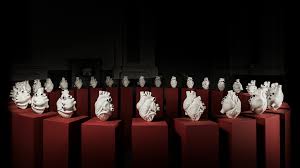Jago in Expo, the ‘circulatory apparatus’ in Italy Pavilion

Rome: The sculptor Jago leads to Expo 2025 Osaka ‘Circulatory apparatus’, a work that explores the link between creativity, technology and human body. The installation, which can be seen by the opening of the Italian Pavilion scheduled for April 13, is part of the dialogue on art as an instrument of regeneration and interpretation, in perfect harmony with the theme of the event: ‘Designing the society of the future for our lives that Italy declines in the theme’ Art regenerates life ‘that guides its pavilion signed by Mario Cucinella.
‘Contemporary art and the visual language used by Jago fully express the goal we want to achieve to the now next universal exhibition of Osaka: updating the image of our country in the world’, underlines the ambassador Mario Vattani, commissioner general for Italy at Expo 2025 Osaka. ‘Art regenerates life is the theme we have chosen for our pavilion, thus placing the emphasis on the dialogue between culture and science. Art is at the service of beauty, but also of well -being, in fact Jago’s work of art will be hosted in the area of the ego in which we investigate the relationship between science, technology and individual, which has always been one of the inspiring elements of our creativity ‘.
‘With a circulatory system I wanted to demonstrate how a solid and apparently immobile material as well as ceramics can get to move and pulsate. Through creativity and technical ability, this work comes to life, transforming itself into an eternal beat. Expo 2025 Osaka is an opportunity to share this research with the world, showing how art and technology can give shape to the invisible ‘, explains Jago.
Made in 2017, a circulatory apparatus was born from the desire to translate the heartbeat into a work of art. Jago first modeled a clay heart, subsequently digitized to obtain a three -dimensional animation of his movement. This process was divided into thirty frames, each of which was converted into a 3D model. The respective chalk kicks have been obtained from these models, inside which the clay was flowed, then cooked and enamelled. The result is a series of thirty hearts, each different from the other, which reproduce the movement of a single beat. Arranged in a circle, a symbol of continuity and infinite, they clean without a beginning or an end, evoking the renewal of life and creation. To complete the installation, a loop video shows the contraction of hearts, transforming the space into an immersive experience, where sculpture comes alive becoming breath, presence and memory.
After installing the sculpture Look Down in New York and made its David opera symbol of the world tour of the Amerigo Vespucci ship, with a circulatory apparatus in Osaka Jago continues his global journey, telling, through a heartbeat, the energy that unites the past, the present and the future of humanity. The installation of the circulatory apparatus therefore celebrates life and its renewal also creating a strong dialogue with the history of art and the lessons of the great masters.
Its sculptural form and its message intertwine with iconic works of the past, present in the Italian pavilion, such as the Atlas Farnese is the deposition of Caravaggio, bringing contemporary art to a direct comparison with the great Italian artistic tradition.
Jago is an Italian sculptor born in Frosinone in 1987. His artistic research founded the roots in traditional techniques and establishes a direct relationship with the public through the use of videos and social networks, to share the production process. At 24 he was selected to participate in the 54th edition of the Venice Biennale, exhibiting the marble bust of Pope Benedict XVI (2009). The youth sculpture was then reworked in 2016, taking the name of Habemus Hominem and becoming one of his best known works. In 2019, on the occasion of the Beyond Mission of ASA, Jago was the first artist to have sent a marble sculpture (The First Baby) on the international space station. In November 2020 he made the installation Look down, which was located in Piazza del Plebiscito in Naples, and then be exhibited in the Al Haniyah desert in Fujairah (UAE).
On October 1, 2021 Jago install his pity in the Basilica of Santa Maria in Montesanto, in Piazza del Popolo (Rome) and on March 12, 2022 the exhibition Jago – The Exhibition in Palazzo Bonaparte in Rome inaugurates. On May 20, 2023 the laboratory in the church of Sant’Astreno Ai Cruciferi (Naples) opens to the public as Jago Museum.





